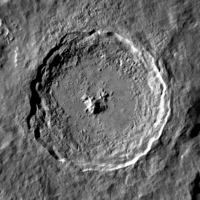
Photo from wikipedia
Abstract Lunar Reconnaissance Orbiter (LRO) Diviner Radiometer, Mini-RF, and LRO Camera data were used to identify and characterize rocky lunar deposits that appear well separated from any potential source crater.… Click to show full abstract
Abstract Lunar Reconnaissance Orbiter (LRO) Diviner Radiometer, Mini-RF, and LRO Camera data were used to identify and characterize rocky lunar deposits that appear well separated from any potential source crater. Two regions are described: 1) A ∼18,000 km 2 area with elevated rock abundance and extensive melt ponds and veneers near the antipode of Tycho crater (167.5°E, 42.5°N). This region has been identified previously, using radar and imaging data. 2) A much larger and more diffuse region, covering ∼730,000 km 2 , centered near 310°E, 35°S, containing elevated rock abundance and numerous granular flow deposits on crater walls. The rock distributions in both regions favor certain slope azimuths over others, indicating a directional component to the formation of these deposits. The spatial distribution of rocks is consistent with the arrival of ejecta from the west and northwest at low angles (∼10–30°) above the horizon in both regions. The derived age and slope orientations of the deposits indicate that the deposits likely originated as ejecta from the Tycho impact event. Despite their similar origin, the deposits in the two regions show significant differences in the datasets. The Tycho crater antipode deposit covers a smaller area, but the deposits are pervasive and appear to be dominated by impact melts. By contrast, the nearside deposits cover a much larger area and numerous granular flows were triggered. However, the features in this region are less prominent with no evidence for the presence of impact melts. The two regions appear to be surface expressions of a distant impact event that can modify surfaces across wide regions, resulting in a variety of surface morphologies. The Tycho impact event may only be the most recent manifestation of these processes, which likely have played a role in the development of the regolith throughout lunar history.
Journal Title: Icarus
Year Published: 2017
Link to full text (if available)
Share on Social Media: Sign Up to like & get
recommendations!